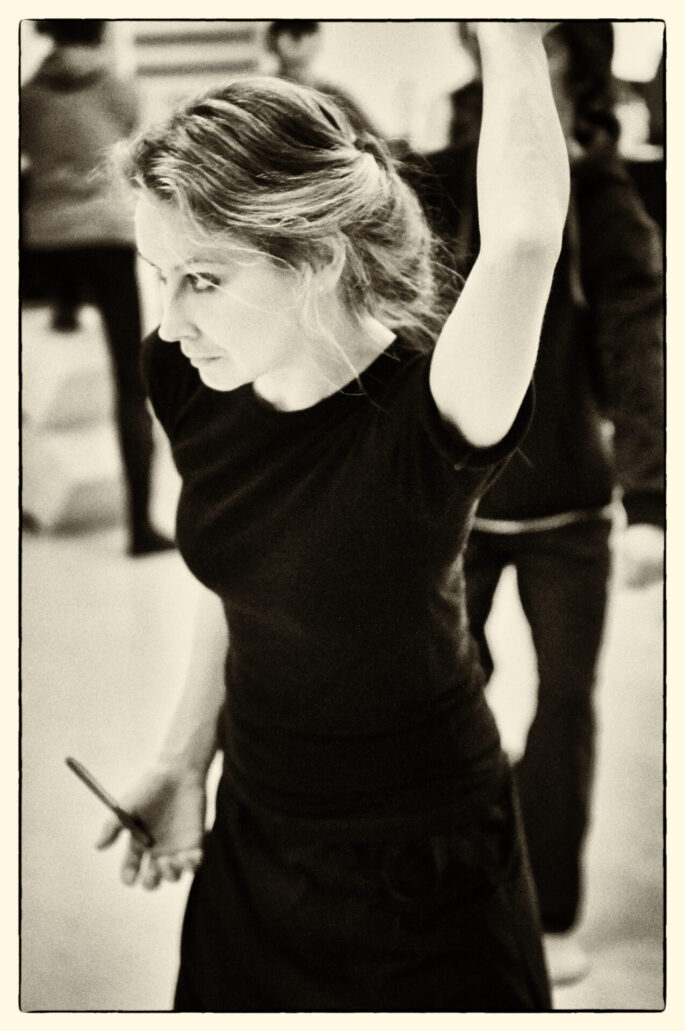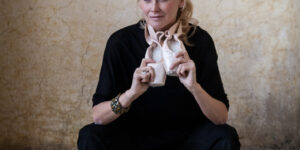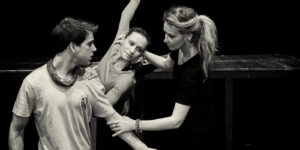ALENA PEŠKOVÁ 0 THE CONSECRATION OF SPRING, ORDER, DISCIPLINE AND THEMES WORTH ELABORATING IN BALLET
Theatre review of the J.K.Tyl Theatre in Pilsen, December 2015
Sacrifice... one of the concepts that struck me in connection with the Consecration... perhaps a bit far from today's trend, when all the advertisements for "life" offer everything for so little or nothing... If I want to get something, do I have to sacrifice something? But for what?... for an idea... And are we able to question any one immediately today? And what are we willing to sacrifice? Life? Paradoxically, perhaps more than comfort... it's not bad to die slowly in the warmth with a full belly in front of the TV the news of the famine on the other side of the world... but whatever the sacrifice and whatever it is for... what if it becomes conscious... wanted... it stops having a touch of suffering, it becomes a gift... unconditional... I expect nothing, because giving itself becomes a bliss... maybe an obsession...
In my imagination, the figure of the composer - and maybe it's not even Stravinsky - who is being passionately kissed by his Muse and whispering, "Then dare!, write what sounds in your head, what no one has heard, what no one may understand... Will you sacrifice... your famous name, your position, maybe even your health, your financial security... on the altar of truth and the development of music...?" ...and he - nods, sacrifices consciously and unconditionally... and at that moment sacrifice becomes for him the greatest experience and enjoyment... he himself then creates in his work the figure of the Sacrifice, which can only be redeemed by another Sacrifice... Love - will it overcome even death? ...yes, even a fanatical crowd... unprepared for new orders, for new "disharmonies", a crowd that always has to find a culprit for the fact that the seed has not germinated and the composer - after setting his body - the work of stoning - expecting nothing, receives back everything he has laid on the altar many times over.
Our production begins with a prologue in which the composer reminisces about the future - Stravinsky is looking at CDs of his music, reading articles about himself, and watching a woman who comes into the Music Shop to choose music... and who - perhaps accidentally, perhaps consciously - puts Stravinsky's beautiful neoclassical work into the "music closet" of Apollo - the leader of the muses... and everything returns, or... right now it is transforming. The birth of the artist... The woman becomes the very Muse who demands sacrifices, she also brings in the crowd - a society that celebrates and damns him... but this society is eventually persuaded by the composer, accepts his play on play, ...and with their own bodies, they revive his scandalous work... a game that becomes more and more absorbing, because we are all playing ourselves - again - a fanatical crowd... and only the composer is able to stop everything, perhaps to correct it. "How do you like your role?"... maybe we just need to listen again... and often it also depends on WHAT we want to hear... and again it is the sacrifice of the individual that can move society... and again Love and Death - as Roland Petit said... the only themes worth processing in ballet...
The basic unchanging point of the scene is a kind of object - a shot piano, the shot of which is, of course, subjected to the strictest order, discipline - the brother-scenographer really "played" with golden cuts... of what this is a symbol I can explain best by quoting Stravinsky: "The necessity of discipline, of a resolutely accepted form, springs from the very depths of our nature and applies not only to artistic things but to all conscious manifestations of human activity. It is the need for order, for without it nothing can be done, and if it is removed, everything falls apart. And there is no order where there is no discipline. But he would be mistaken who thinks that it is detrimental to freedom. On the contrary, form, discipline, contribute to its development, and only prevent it from degenerating directly into licentiousness. In the same way, if a creative artist uses ready-made and established forms, he is not limited in any way in the expression of his own personality. Moreover, it is freed up, it stands out much better when it moves within a conventional, fixed framework."
And then as far as the set is concerned, there is something I am very much looking forward to, but at the same time dreading... grain, bags of grain, sprinkled grain forming patterns on black ballet, swept grain, grain mandalas... by this stage the dancers will have their toes off... yet I can imagine how it hurts, slips, sticks, rolls... and I can also imagine how everyone involved will "love" me. I know that I run the risk of making them very uncomfortable, but... I decide to sacrifice myself:) ... for an artistic idea :)
... yes, he who treats what he misses also misses it, and this is doubly true for ideas. Well, when the fanatical crowd of angry dancers and artistic-technical workers will run against me, I will be left only with my perverted ideas and the belief that Love will overcome even Death...:)
I'm really looking forward to seeing the ensemble again, although it has changed a lot since Blood Wedding, and there are completely new faces for me. Unfortunately I haven't caught Romeo and Juliet yet, but I just saw the last premiere on the Small Stage and also Death in Venice, which I really liked... The ensemble looks compact and young. And I'm also looking forward to the new space.
THEATRE REVIEW 2015




Comments are closed.